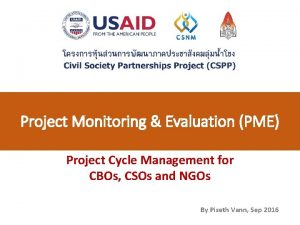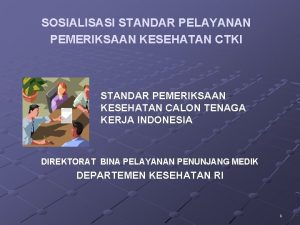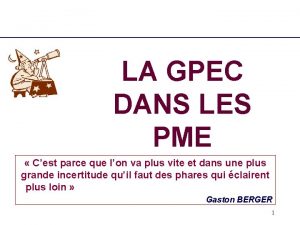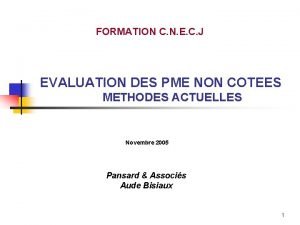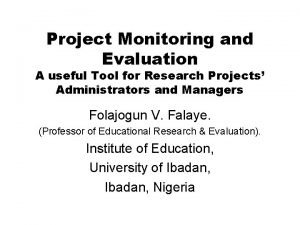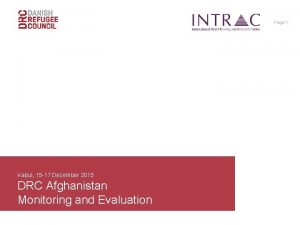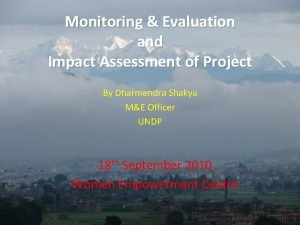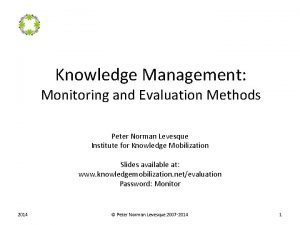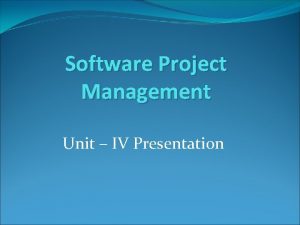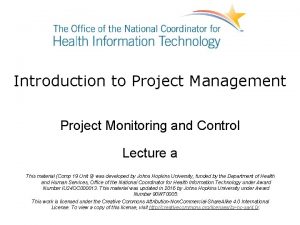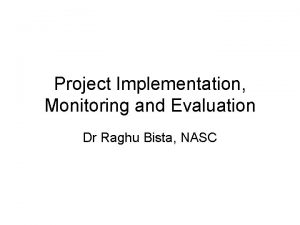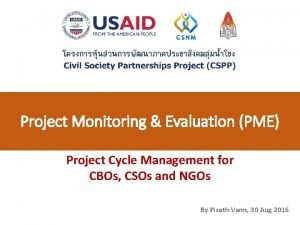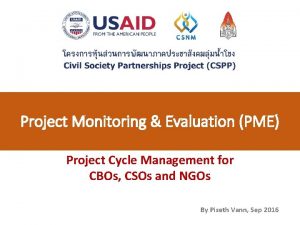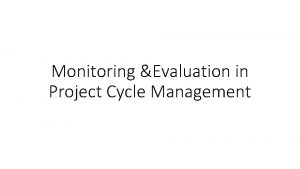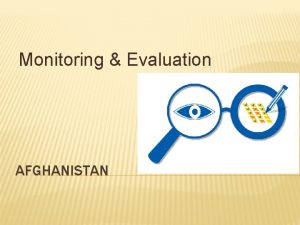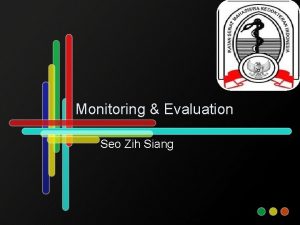Project Monitoring Evaluation PME Project Cycle Management for
















- Slides: 16

Project Monitoring & Evaluation (PME) Project Cycle Management for CBOs, CSOs and NGOs By Piseth Vann, Sep 2016

Table of Contents 1. • • 2. 1. 2. 3. 4. General Introduction Self-Introduction Objectives of the M&E training module Contents of the M&E module Pre-Test Overview of Project Monitoring & Evaluation (PME)? What is Project Monitoring & Evaluation? Why is M&E important in PCM? How to ensure obtaining effective PME? Recommended tools and/or techniques to be used in PME 2

Table of Contents (cont) 3. M&E in Project Cycle Management 1. Definitions 2. Why M&E important in PCM? 3. The differences between Monitoring & Evaluation 4. M&E System and Framework 1. Elements of a Good M&E system 2. Tasks in M&E 3. Steps in M&E system 4. Key Criterion for Evaluation 5. Planning and Steps for Project Monitoring & Evaluation (PME) 5. Database Management System and 1. What is Database Management System (DMS)? 2. Why DMS is important in Project Cycle Management? 3. How to do it? and suggested tools 9/13/2021 3

Table of Contents (cont) 6. M&E Approach 1. M&E Approach 2. Selecting LFA approach 3. Defining Indicators 4. M&E Planning & Budgeting 7. M&E Report 1. What is M&E report? 2. Why is it important to have M&E report? 3. Process of Reporting and Dissemination 4. Internal versus external reporting 5. Characteristic of Good M&E Reporting Conclusion session • Post-Test and Evaluation • Certificate ceremony (if any) 4

1. General Introduction • • • Welcome participants Self-Introduction Objectives of the M&E training module Contents of M&E training Clarifying expectations of participants Pre-Test 9/13/2021 5

Overall Objectives of the M&E training module 1. Understand key elements of project monitoring and evaluation and its cycle within the project or program 2. Understand key functions of M&E in project or program, system and framework as well as evaluation criteria 3. Understand adopt some methods and tools for effective project Monitoring& Evaluation 4. Understanding about database management that need to work along side with M&E 5. Understand adopt some reporting template to use in their organization 9/13/2021 6

2. Overview of Project Monitoring & Evaluation (PME)? 9/13/2021 7

Overview of the Project Monitoring & Evaluation? Objective: After this session, participants will be able to understand key elements of project monitoring and evaluation 8

1. What is Project Monitoring & Evaluation (PME)? Definitions— PME • It is a process that helps improve performance and achieve results of the project. Its goal is to improve current and future management of outputs, outcomes and impact. 9

Definitions-- “Monitoring” (Cont) • A management activity that allows a continuous adaptation of the intervention if problems arise or if changes in the context have an influence on the performance of the operation. • The systematic collection of information on all aspects of the project while it is being implemented. • A continuing function that aims primarily to provide the management and main stakeholders of an ongoing intervention with early indications of progress, or lack thereof, in the achievement of results. 10

Definitions– “Evaluation” • A systematic and objective assessment of ongoing or completed project. It makes comparison of the outcomes of the project with planned ones. • An assessment, as systematic and objective as possible, of an ongoing or completed project, programme or policy, its design, implementation and results. The aim is to determine the relevance and fulfillment of objectives, developmental efficiency, effectiveness, impact and sustainability. An evaluation should provide information that is credible and useful, enabling the incorporation of lessons learned into the decision-making process of both recipients and donors. 11

Definitions– “Evaluation” (cont) • The process of determining the worth or significance of a project to assess relevance of objectives, efficacy of design and implementation, efficiency or resource use, and sustainability of results. An evaluation should (enable) incorporation of lessons learned into the decision-making process of both partner and donor. • It is important to remember: üEvaluation requires study design. üEvaluation sometimes requires a control or comparison group. üEvaluation involves measurements over time. üEvaluation involves special studies 12

2. Why is M&E important in PCM? A well-functioning M&E system is a critical part of good project/program management and accountability. Timely and reliable M&E provides information to: • Support project/program implementation with accurate, evidence based reporting that informs management and decision-making to guide and improve project/program performance. • Contribute to organizational learning and knowledge sharing by reflecting upon and sharing experiences and lessons learned so that we can gain the full benefit from what we do and how we do it. 13

Why is M&E important? (Cont) • Uphold accountability and compliance by demonstrating whether or not our work has been carried out as agreed and in compliance with established standards and with any other donor requirements. • Provide opportunities for stakeholder feedback, especially beneficiaries, to provide input into and perceptions of our work, modeling openness to criticism, and willingness to learn from experiences and to adapt to changing needs. • Promote and celebrate our work by highlighting our accomplishments and achievements, building morale and contributing to resource mobilization. 14

3. How to ensure obtaining effective PME? q. To be an effective for project monitoring and evaluation, the organization need to ensure that it have adequate resources (human and financial resources) allocated to this particular task. q. All relevant data or information (baseline and endline data) is needed to be in place to guide and support decision during the project implementation and even dealing with design any policy for the organization. 9/13/2021 15

4. Recommended tools and/or techniques to be used in PME • There are many tools for monitoring and evaluation of the project or program. Some tools are really scientific research tools and some project is more on biological survey or rocket science which is required different tools. But in this M&E training for NGOs and CBOs, the recommended tools or techniques are: üLogical Framework Analysis (LFA), üEnvironmental Impact Assessment (EIA), üSocial Impact Assessment (SIA) and üStrength, Weakness, Opportunity and Threat (SWOT) analysis. • Among these tools, LFA is the most popular one among development partners, NGOs and especially donors or funders. LFA is strongly related to results- based management framework and DAC Criteria. However, please refer this tool back to the training module 2 of PCM. 9/13/2021 16
 Monitoring and evaluation in project life cycle
Monitoring and evaluation in project life cycle Pme radiologi
Pme radiologi Plano municipal de educação campo grande ms
Plano municipal de educação campo grande ms Etapas del pme
Etapas del pme Gpec pme
Gpec pme Etapas del pme
Etapas del pme Calcul du cmpc
Calcul du cmpc Pme demo password
Pme demo password Ntbr pme
Ntbr pme Difference between monitoring and evaluation
Difference between monitoring and evaluation Example of monitoring and evaluation in project proposal
Example of monitoring and evaluation in project proposal Monitoring and evaluation plan sample
Monitoring and evaluation plan sample What is strategic assessment in software project management
What is strategic assessment in software project management Knowledge management monitoring and evaluation
Knowledge management monitoring and evaluation Ball chart in spm
Ball chart in spm Project management monitoring and controlling
Project management monitoring and controlling Comparison between monitoring and evaluation
Comparison between monitoring and evaluation
